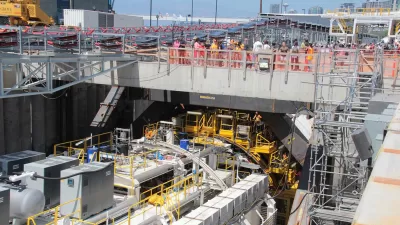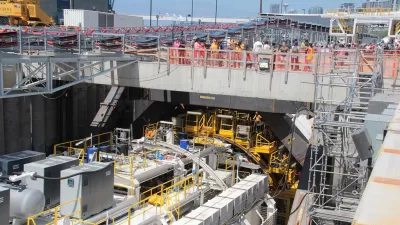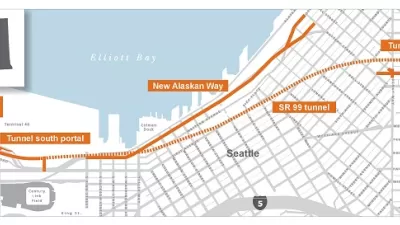Baby steps are an improvement for the tunnel-boring machine known as Bertha. The drill moved a total of 1.5 feet this week, but the symbolic distance probably felt like a mile.

"Workers at the Seattle waterfront switched on the power to the world’s largest boring machine and revved it forward early Tuesday," reports Mike Lindblom, "bringing hope to the Highway 99 tunnel project after a two-year delay."
Bertha had a breakthrough moment back in February when it moved far enough to remove a section of the drill for repairs.
The most recent development in the saga, moving the drill forward 1.5 feet, is considered a test. But this test has a particularly critical air to it according to Linblom: "Government agencies lack a Plan B, so failure is not an option.
Buried at the bottom of the article are some of the details of fallout fro the two-year delay, including the cost of the repairs:
"The main partners, Dragados USA of Spain and Tutor-Perini of California, have said in court documents that overall costs for repair, including excavation of the giant repair-access vault, are expected to exceed $143 million. It could take years for STP, Hitachi Zosen, their insurers, and Washington state to sue or negotiate who pays for repairs and delays, beyond the basic $1.35 billion STP contract."
FULL STORY: Bertha back on the move after 2 years of delays

Maui's Vacation Rental Debate Turns Ugly
Verbal attacks, misinformation campaigns and fistfights plague a high-stakes debate to convert thousands of vacation rentals into long-term housing.

Planetizen Federal Action Tracker
A weekly monitor of how Trump’s orders and actions are impacting planners and planning in America.

San Francisco Suspends Traffic Calming Amidst Record Deaths
Citing “a challenging fiscal landscape,” the city will cease the program on the heels of 42 traffic deaths, including 24 pedestrians.

Defunct Pittsburgh Power Plant to Become Residential Tower
A decommissioned steam heat plant will be redeveloped into almost 100 affordable housing units.

Trump Prompts Restructuring of Transportation Research Board in “Unprecedented Overreach”
The TRB has eliminated more than half of its committees including those focused on climate, equity, and cities.

Amtrak Rolls Out New Orleans to Alabama “Mardi Gras” Train
The new service will operate morning and evening departures between Mobile and New Orleans.
Urban Design for Planners 1: Software Tools
This six-course series explores essential urban design concepts using open source software and equips planners with the tools they need to participate fully in the urban design process.
Planning for Universal Design
Learn the tools for implementing Universal Design in planning regulations.
Heyer Gruel & Associates PA
JM Goldson LLC
Custer County Colorado
City of Camden Redevelopment Agency
City of Astoria
Transportation Research & Education Center (TREC) at Portland State University
Jefferson Parish Government
Camden Redevelopment Agency
City of Claremont




























